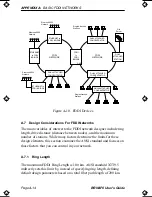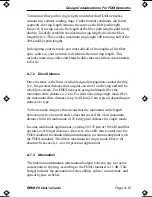
APPENDIX A: BASIC FDDI NETWORKS
Page A-2
BRIM-F6 User’s Guide
When a station has a frame waiting to transmit, the station captures the
token at the next opportunity, transmits the data frame, and then reissues
the token. (A Token Holding Timer (THT) controls the maximum length
of time that any station may retain the token.) Each station receives and
repeats the data frame as it circulates around the ring. When the frame
arrives at the station defined by the destination address, the receiving
station copies the frame into its buffer and forwards with information
reflecting the receipt of the frame and related frame status. After the data
frame circulates completely around the ring, the source station strips the
data frame from the ring.
FDDI networks use duplex fiber optic cable for point-to-point
connections between a number of stations to form two closed loops. The
two rings serve as redundant (primary and secondary) data paths that
operate as counter-rotating rings. Redundant rings facilitate recovery
procedures in the event of a ring segment failure. This recovery resembles
that in Token Ring/IEEE 802.5 networks. This Appendix discusses this in
greater detail later in this section.
The FDDI standard defines two ring access methods, single attachment
and dual attachment (see Figure A-1). Dual attached stations (DAS)
and dual attached concentrators (DAC) connect to both primary and
secondary rings and can restore ring continuity in the event of a segment
failure. Single attached stations (SAS) and single attached
concentrators (SAC) cannot restore ring continuity and therefore cannot
reside on the main ring path.
Single attached devices access the main ring through a DAC and duplex
fiber optic cable connections. These connections form branches that
extend from the DAC out to each of the attached SASs, creating a Ring of
Trees topology. The DAC controls main ring access to the attached SASs,
restoring the continuity of the ring whenever an SAS fails, becomes
disconnected, or is turned-off.
BRIM-F Book Page 2 Monday, January 29, 1996 9:26 AM
















































